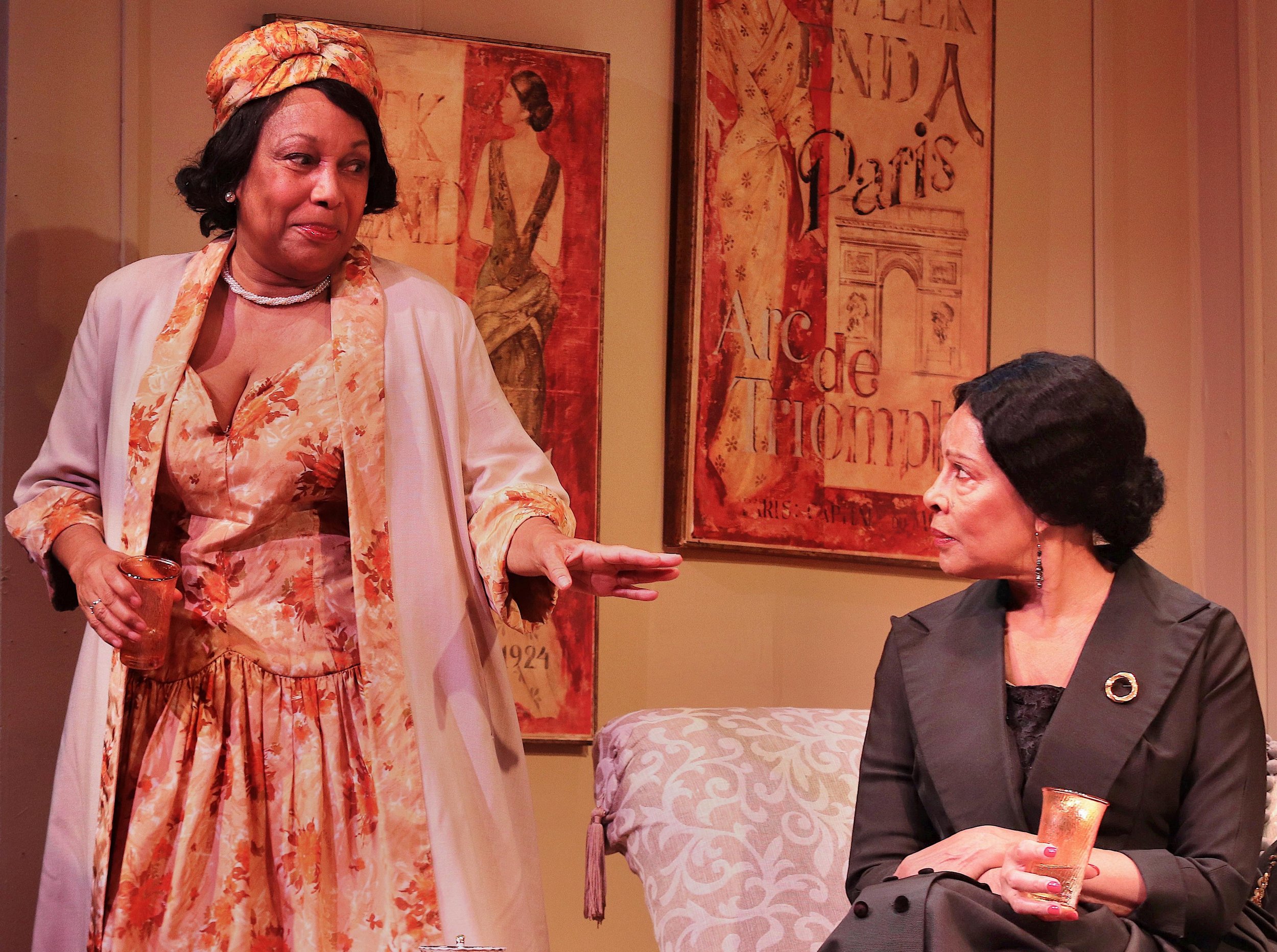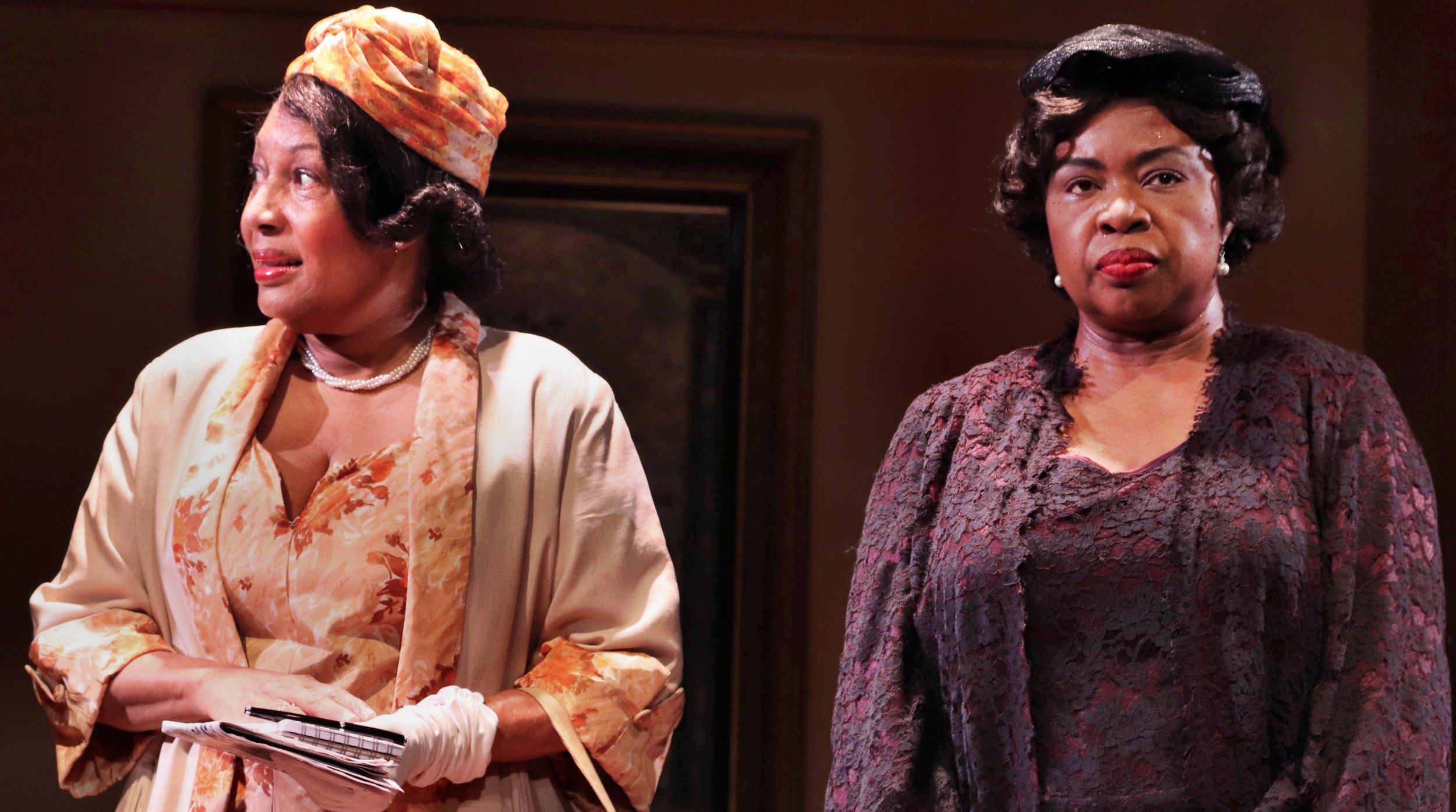Zora Neale Hurston (Elizabeth Van Dyke, left) confronts Nella Larsen (Petronia Paley) about her alleged plagiarism.
Four matrons of the Harlem Renaissance, all feisty, confident, and accomplished authors, activists, and folklorists, recall racial discrimination and the realities of a man’s world in Wesley Brown’s Telling Tales Out of School. Set in 1954, a seminal moment for civil rights, the play finds the quartet—Zora Neale Hurston (Elizabeth Van Dyke), a black anthropologist and author; Nancy Cunard (June Ballinger), a white, left-leaning Cunard heiress, activist and editor; Jessie Fauset (Richarda Adams), a black editor and poet; and Nella Larsen (Petronia Paley), a biracial former nurse and novelist—becoming reacquainted in Brown’s imagined reunion.
A bangle-studded Nancy Cunard (June Ballinger) reminisces about her life and loves.
Though the women are now in their sixties, and they meet under less than joyful circumstances, time has not quenched the fire in their bellies. The women’s interactions convey racial tensions and struggles in writing. They initially appear sedate, but director Woodie King Jr. positions their passions, anger, and shared pain at the vortex of an emotion-laden theatrical tornado. They dance with abandon but can easily be confrontational.
The women’s serendipitous encounter comes at a funeral for Alain Locke, who is eulogized by W.E.B. DuBois. Most of them don’t like this darling of the Harlem Renaissance. When Larsen shares gossip about Locke’s relationship with his mother, Fauset responds, “I wish he had given a fraction of that consideration to Negro women writers. But except for his mother, I don’t think he cared much for women.”
Since their last encounter, the women have aged gracefully. Hurston and Cunard, arms adorned by multiple bangles, are stylishly attired. Fauset and Larsen are conservatively but tastefully dressed. Costume designer Gail Cooper-Hecht captures diverse period styles, in sync with each character’s personality.
Hurston has been assigned by the Pittsburgh Courier to report on the funeral, but it is unclear why the others are attending. Cunard pursues civil rights for Negroes and coloreds (that’s how the women refer to their race). She has rejected her privileged life, saying, “After seeing the damage that people of my mother’s pedigree have done to themselves and the world, I’ve spent my life not being part of it.” Yet she still invites the others for tea, in an elegant British gesture. Chris Cumberbatch’s set design reflects Cunard’s ornately upper-class taste.
In this genteel domicile, after tea and cakes have been served, and small talk about Locke and his failings ends, Cunard, at Hurston’s urging, offers liquor. Hurston has seen this tea as an opportunity “to tell each other some tales out of school,” and the vodka is a catalyst for the women’s tongues to loosen up. Cunard dances seductively to jazz music.
“This powerful story is about resolute yet vulnerable women who helped usher in political, social, and cultural change. ”
Hurston suggests a party game that was played in the 1920s, “Quiet as It’s Kept,” in which “we would come up with terrible things we’d either witnessed or heard about somebody and tell everyone present what it was.”
Emboldened by alcohol, the women lose no time descending into gossip and insults that nearly rival the viciousness of George and Martha in Who’s Afraid of Virginia Woolf?
Each woman finds the Achilles heel in one of the other’s failures, controversies, and for Cunard and the light-skinned, mixed-race Larsen, white privilege. They all take pleasure in one another’s respective literary shortcomings, disastrous romantic liaisons, and bourgeois pretentions. For instance, Fauset tells Larsen: “It was said that your departure from the literary scene was your shame over being accused of plagiarism and then having it proven to be true.”
Hurston (Van Dyke, left) and Jessie Fauset (Richarda Abrams) recall their struggles as female authors in a man’s world. Photographs by Lia Chang.
Larsen’s alleged plagiarism and Cunard’s lengthy affair with African American jazz musician Henry Crowder rank high on the disaster list; Hurston’s Negro Anthology and Fauset’s work suffered the literati’s rebuke. Beyond the collective mudslinging, the fine actors embody women equally frustrated by a world where black men belittle and lord it over them, exacerbating the barriers already placed upon them by the white world.
When the women have tired of shredding each other, Hurston suggests that they turn inward. “Why not? We’ve already gotten under each other’s skin. Let’s see how deep we can go into the dark, hidden corners of ourselves.” And so they do, in a gut-wrenching, tear-filled way. One by one they find solace in swaying and lip-synching Eartha Kitt’s rendition of “I Want to Be Evil,” ultimately singing them in unison.
This powerful story is about resolute yet vulnerable women who helped usher in political, social, and cultural change. Superbly directed by King, Brown’s script balances intense moments with bittersweet humor and irony, as the women attack one another rather than the system that has oppressed them.
Telling Tales Out of School runs at the New Federal Theatre (543 W. 42nd St.) through Nov. 12. Evening performances are at 7:30 p.m. Tuesday through Saturday; matinees are Sunday at 3 p.m. For tickets or more information, call the box office at (212) 353-1176 or visit newfederaltheatre.com.
Playwright: Wesley Brown
Director: Woodie King, Jr.
Set Design: Chris Cumberbatch
Lighting Design: Antoinette Tynes
Costume Design: Gail Cooper-Hecht
Sound Design: Bill Toles





